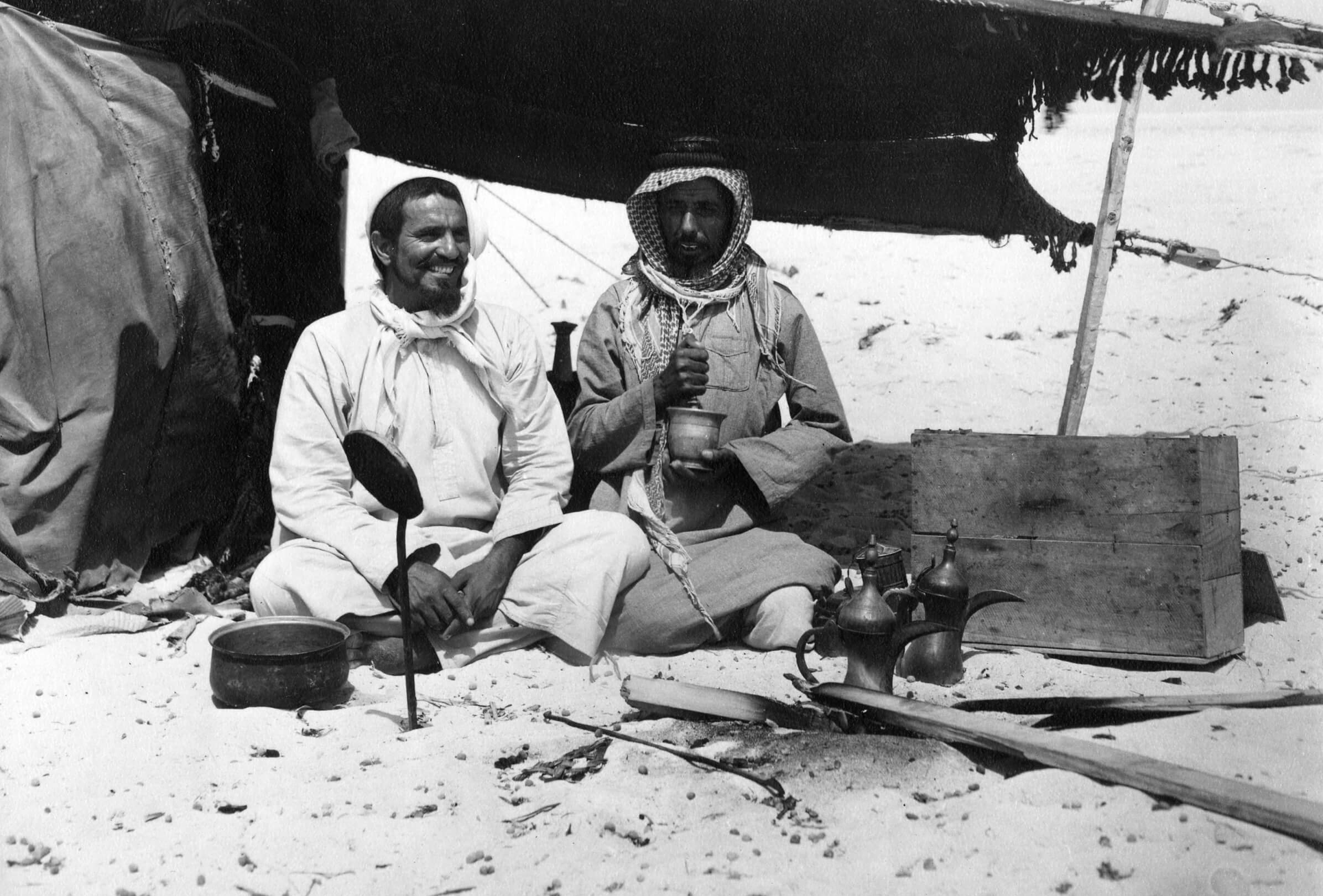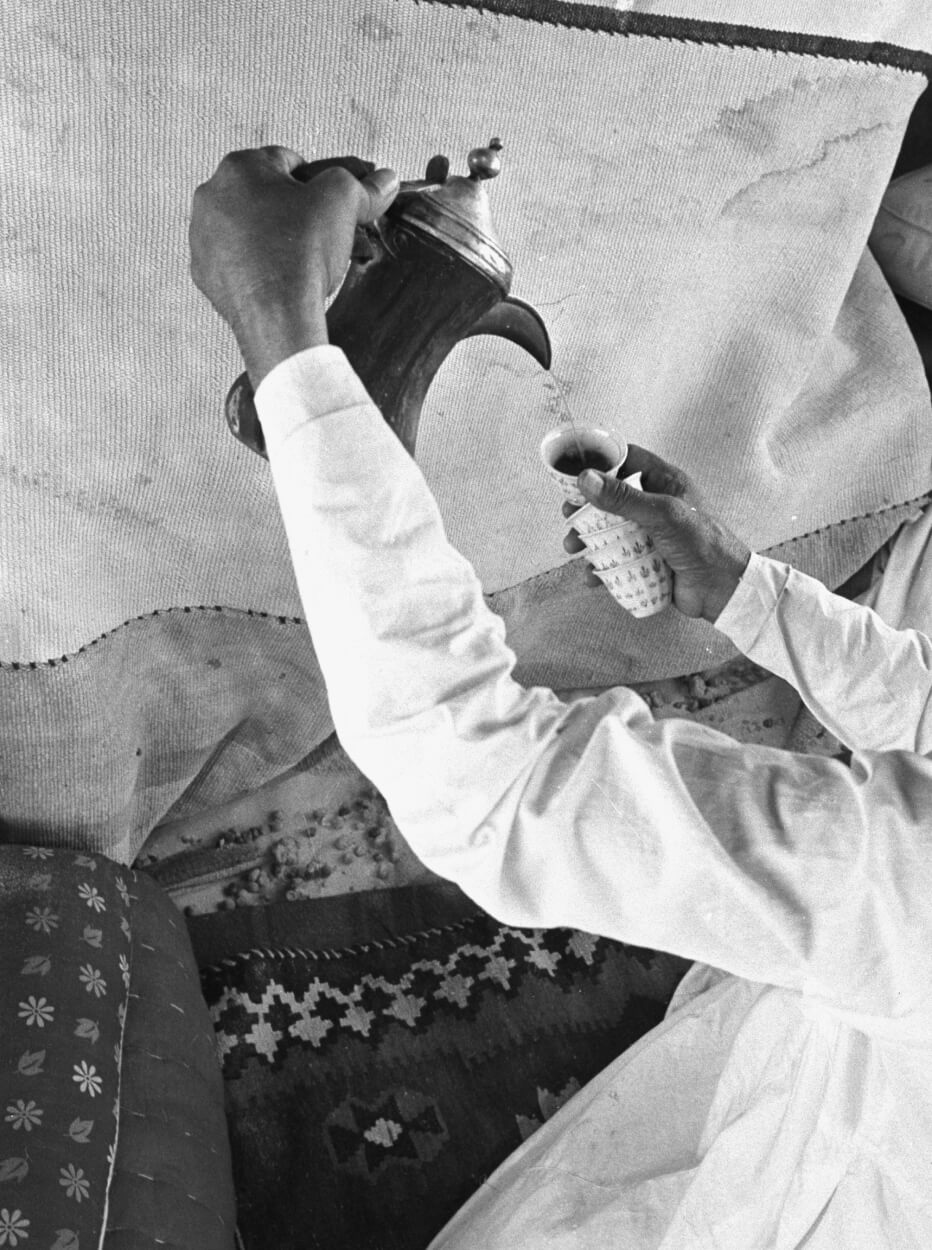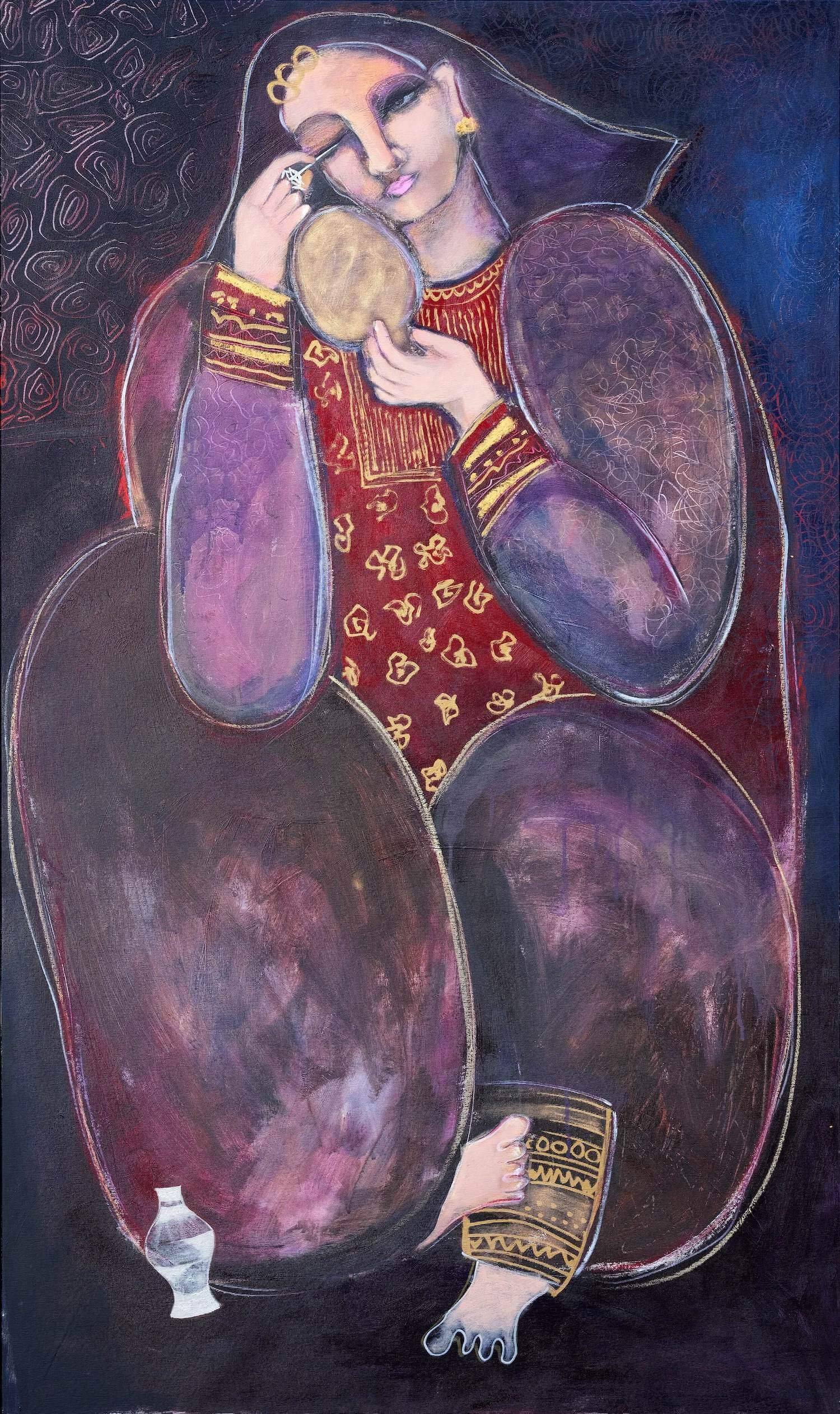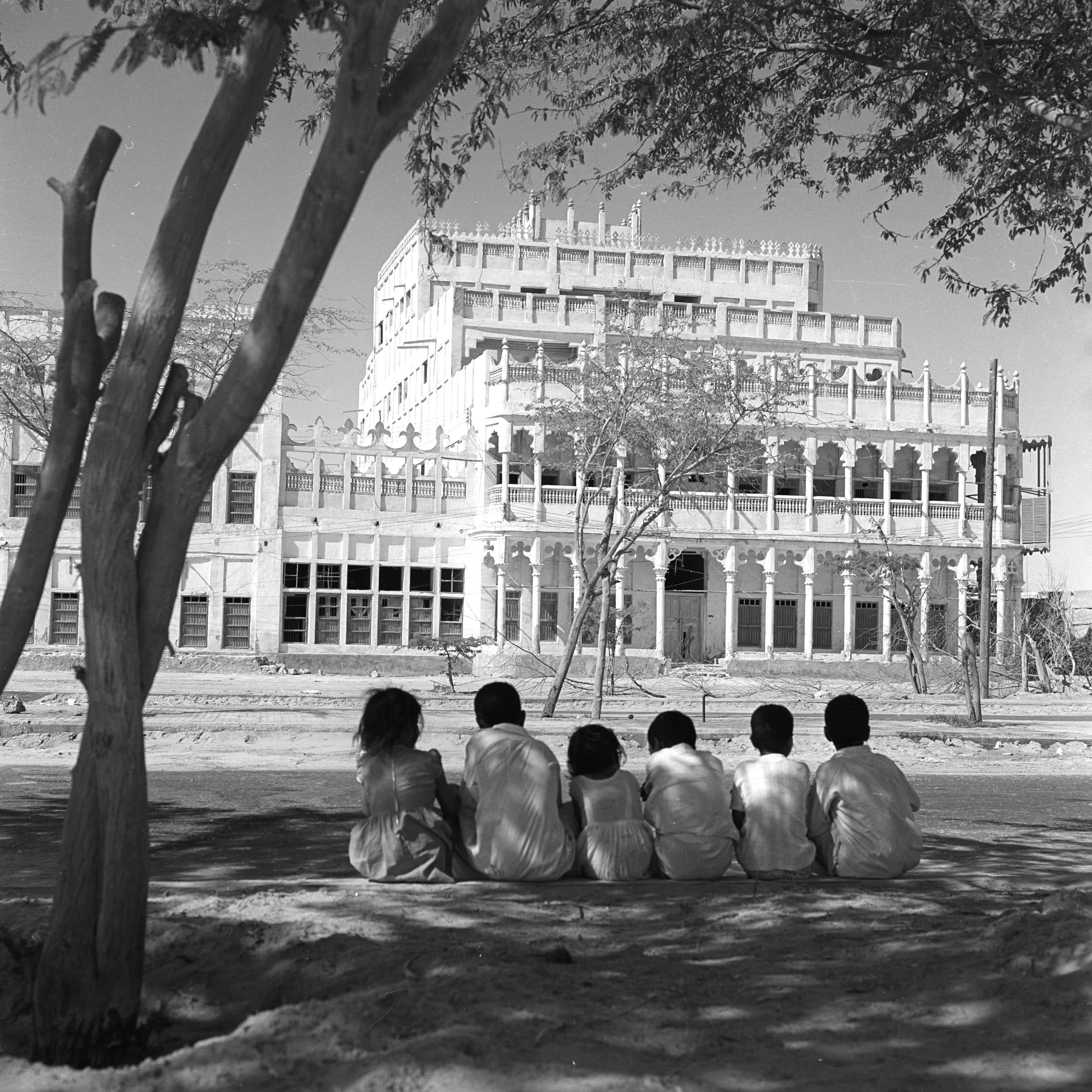The identity of Saudi coffee
“Men of Saudi Arabia” Faisal Al-Khuraiji, 2020. 150-150X cm. Acrylic on canvas. To read more about the artist, see the Khaleeji Art Museum article.
Coffee is closely related to the Saudi Arabian identity. It has been present in Arab culture for hundreds of years, so it has become an integral part of Arab social life. Civilization, customs and traditions are represented in the cup of coffee as a symbol of the generosity and hospitality that characterizes the Arabs of the past and present.
The cup was the companion of the poet and the artist in their isolation or their meeting place. Because of the importance of coffee in Saudi culture, the Ministry of Culture launched the “Saudi Coffee Year” initiative. It is a unique cultural product that is linked to the Saudi identity, and reflects the great cultural diversity in the Kingdom through the diversity of ways of preparing and serving Saudi coffee.
Abdullah bin Nasser bin Kulaib is interested in heritage, especially coffee, and writes about it and provides consultations. He studied architecture and was fascinated by the diversity of cultures and their impact on designs and people's lives. His passion led him to travel across the world, visiting various countries such as Ethiopia, Costa Rica, Cuba and Mexico, where he read people, browsed the features of people, and sipped their intellectual and heritage products to better understand them.
Ithraeyat Magazine interviewed him to evoke his passion and knowledge of the heritage and traditions of Saudi coffee from central Arabia, with his deep understanding and awareness of the differences between one region and another.

Arabic and Saudi Coffee, a tradition of friendship and hospitality. Undated, courtesy of Aramco Archives.
Q1. What is the difference between Saudi coffee and other types of coffee?
Saudi coffee was distinguished as a symbol of hospitality, generosity and live celebration. Saudi coffee was not sold, but rather provided as hospitality, and was not presented as a commodity from its first appearance, and this is what distinguishes it.
It was the first thing presented to the guest as a messenger of love and peace between hosts and guests. Saudi coffee has a beautiful characteristic in preparing it in front of the guest as a ritual and a full-fledged theatrical scene to pervade the aroma of coffee in the Majlis, and the breath of those present mingles with those aromatic perfumes of coffee, saffron and cardamom. They listen to the tones of the grinding bowl with glee, and the sound of pouring cups is accompanied by the voices of those welcoming the guests.
Saudi coffee has many customs and traditions, including the spoken and the unspoken, and among the unspoken is the habit of shaking the cup to subtly signify having had enough, without drawing attention or embarrassing any other guests. It is also customary that the first cup belongs to the one who prepares the coffee, and this cup is called the heif cup because it is a cup to test the quality and temperature of the coffee, and in the pastit was to show that the coffee is not poisoned.
The next cup is called the guest's cup, and it is a cup worthy of the most important guest in the gathering, followed by the cup of mood, which is its indication that the coffee was liked by the guest. There remains the cup of the sword, which is the cup which, as soon as he drinks, an alliance is made between the guest and the host and they are bound by their obligations in war or peace. There is a fifth cup that has been forgotten, and it is the knight's cup; the sheikh of the tribe asks who drinks the cup of so-and-so, meaning that the drinker of this cup must go and ask for the blood of this so-and-so until he returns. The fifth cup is no longer relevant in modern, safe times.
Q2. What distinguishes it?
I see that the way of drinking coffee in a small cup (finjan) is the most important characteristic of Saudi coffee, as it contributes to bringing the guest closer to his host, so he talks to him and welcomes him, and they engage in conversation while providing hospitality. Everyone enjoys a warm atmosphere that you rarely see in other elements of heritage and is characterized by feelings of generosity of hospitality. It is also distinguished by its smooth taste due to its light roasting and aromatic spices.
Q3. Why was it called Saudi coffee instead of Arabic coffee?
From my personal perspective, I see it as a celebration of the coffee that is grown in the Kingdom of Saudi Arabia and the full supply chain involved locally., Thecoffee is grown in the Kingdom, picked and dried by a Saudi farmer, and then prepared to be sold by a Saudi merchant, to be bought and prepared by the owner of the Saudi Majlis with pots made in Saudi Arabia, from a coffee roasting pan (mihmas) and a coffee pot (dallah), all of which is presented with Saudi hospitality.
This is something that is unique to the Kingdom due to its diversity and the comprehensiveness of its lands and the work of its farmers, merchants, manufacturers and hosts. You are in front of a complete Saudi product. Coffee varies from region to region for several reasons, either the strain or even the land and its chemical elements and the method of irrigation, whether it is from rain or from wells.
Q4. What are its components? How is it made? Is there a time of the day designated to drink it?
Saudi coffee has recipes that we can reduce to five general ingredients, which consist of: coffee, cardamom, clove, saffron and mastic. As for the time, it is divided into two scenarios, the first is the time of the guest’s arrival, whatever the time, and the second is the early morning before dawn in the past, and now after sunrise, noon and after sunset. The Maghrib (sunset) coffee was to expel drowsiness in order to wait for the Ishaa (evening) prayer, or Al-Amas and narrow-mindedness before sleeping, so he sleeps happy and cheerful.
Q5. Does the way it is prepared differ from one city to another?
Yes, it varies, and I see that it has something to do with the atmosphere. In hot weather, one craves light aromatic recipes, and in cold weather, one craves dark and heavy coffee.
As is the case with most inherited cultures, they originated from necessity and rationality.
Just to name a few examples, the coffee of the Central region (Najd) is distinguished as being blonde and with the addition of saffron and clove. Unlike the coffee of the Eastern region, where they don’t use clove. As for the coffee of the South, it is characterized by the addition of ginger and some cinnamon. The coffee of the Western region (Hijazi) is unique by adding mastic, while the coffee of the North and its mountains is roasted darker and with cardamom, so its texture is heavier and dense.

Saudi Coffee, a tradition of hospitality and survival. Undated, courtesy of Aramco Archives.
Q6. Is coffee a kind of heritage?
Yes, it is a heritage and has been registered with UNESCO as an intangible cultural heritage. The importance of registration lies in highlighting more and reviving conservation efforts.
Q7. Why are Saudis proud to show coffee? Why is it important to spread it to the world?
The interest of the Arabs in coffee stems from their interest in honoring the guest and being a good neighbor. As you know, the hospitality of the Arabs after Islam was milk, and some tribes were known as the people of Mathloutha (three types), meaning that their hospitality is three things: milk, dates and meat.
Then milk was replaced with coffee and it became the hospitality drink.
As for spreading it to the world, it is one of the good practices and beautiful morals which nations possess and by which they converge and coexist. Generosity is the origin of all good, and miserliness is the origin of all evil.
The spread of hospitality and generosity helps to bring peace and love between people and races.

Arabic and Saudi Coffee, a tradition of friendship and hospitality. Undated, courtesy of Aramco Archives.
Q8. What is the relationship of coffee to the start of celebrations and social events?
Saudi coffee is the drink of hospitality and the messenger of peace between the guest and the host, and do not forget that preparing coffee in the Majlis makes it filled with a pleasant aroma; the smell of coffee, saffron, cardamom and blue oud clears the mind and pleases the heart.


